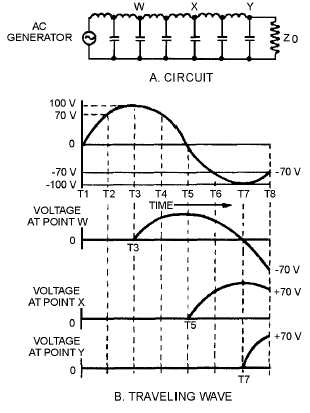3-22
Figure 3-21.—Ac applied to an equivalent transmission line.
In view B the generator voltage starts from zero (T1) and produces the voltage shown. As soon as a
small voltage change is produced, it starts its journey down the line while the generator continues to
produce new voltages along a sine curve. At T2 the generator voltage is 70 volts. The voltages still move
along the line until, at T3, the first small change arrives at point W, and the voltage at that point starts
increasing. At T5, the same voltage arrives at point X on the line. Finally, at T7, the first small change
arrives at the receiving end of the line. Meanwhile, all the changes in the sine wave produced by the
generator pass each point in turn. The amount of time required for the changes to travel the length of the
line is the same as that required for a dc voltage to travel the same distance.
At T7, the voltage at the various points on the line is as follows:
At the generator:
-100 V
At point W:
0 V
At point X:
+100 V
At point Y:
0 V
If these voltages are plotted along the length of the line, the resulting curve is like the one shown in
figure 3-22, view A. Note that such a curve of instantaneous voltages resembles a sine wave. The changes
in voltage that occur between T7 and T8 are as follows:

